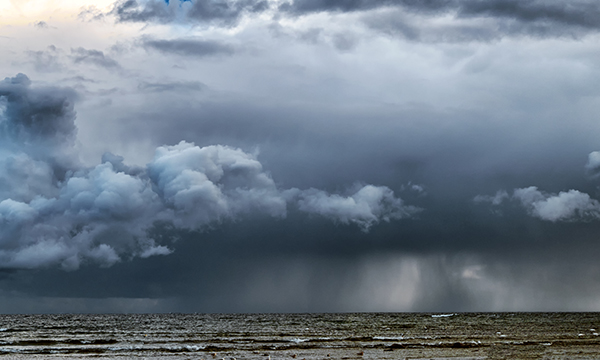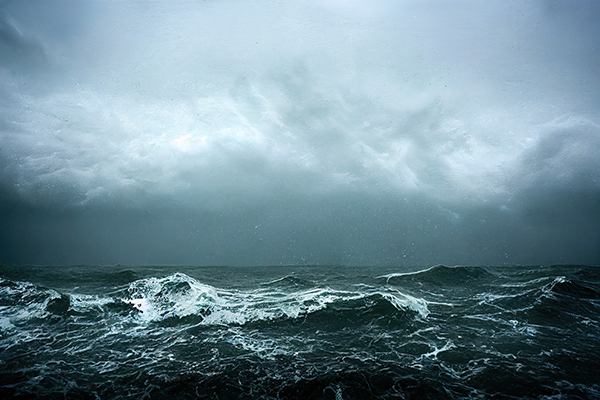Boating in the Wind
Windy conditions have canceled more boat days than perhaps anything else. Wind can not only make spending time on a boat uncomfortable, but unsafe. Understanding how to operate safely in the wind is critical for anyone who owns or plans to spend time on a boat. This starts with knowing your boat and its capacity for handling wind. It also includes some pointers for safely and comfortably driving your boat in windy conditions.
Knowing When to Go and When to Stay
Understanding safe boating conditions involves considering several factors:
1. Your Boat- size, hull shape and power
2. The body of water you’re boating on
3. The speed and direction of the wind
Your Boat
The size, hull shape and power of your boat are some of the primary determinants of how much wind you can safely operate in. Generally speaking, the deeper the v of the hull, the more wave action (and wind) your boat can tolerate.
Consider the difference between a walleye boat (with a deep v) that is designed to operate on big, open water of the Great Lakes and a bass boat. Many walleye boats are designed to operate in areas of more wave action.
Compare this to the standard bass boat design. Flatter and quicker to come on plane, you’ll become less comfortable and less safe with more wind on a bass boat than in a deeper vee hull.
In the saltwater space, you’ll see deeper deadrise in hull shapes as you get further from shore. Shallow water skiffs are flatter-bottomed than bay boats. Bay boats have less vee than offshore boats.
So, a first step to safe operation in wind is to know and understand the limits of your boat. The next step involves considering the wind in relation to the body of water where you’ll be fishing.

The Body of Water and the Speed and Direction of the Wind
While wind speed is important, it’s also useful to consider the direction of the wind and how the body of water you’re fishing behaves. The longer the distance that wind blows unimpeded across water, the more wave energy it will generate.
This distance is known as fetch or sometimes reach. The greater the distance of the fetch, the more powerful the wave energy it will generate.
If you’re fishing the north end of a big lake and a strong wind blows steady out of the south, you’re likely in for some bumpy water. If the wind blows out of the north, however, and you’re fishing near shore, you’ll likely be protected from the worst of it. So, consider the wind direction and the shape and size of the place you’ll be boating. The further from shore, the greater the impact you’ll likely experience.
If you’re fishing on the coast, you’ll want to also consider the effect of tide. At such places as the mouths of inlets, the effect of wind on tide can stack waves or create dangerous conditions.
Consider these conditions, alongside the wind forecast, in relation to your boat’s capacity before leaving the dock. If you’re inexperienced or unsure, there are times when caution is your best bet. The fish will be there on a day with less wind.

How to Operate in Windy Conditions
Once you’ve taken care to not be stuck in unsafe conditions, let’s consider how to operate your boat in the wind. You have most control when running into the wind. To find the most comfortable ride, point your bow into the wind (the waves). Find the speed at which you are moving comfortably, without pounding.
Once you find the sweet spot on the throttle, adjust your heading to get to where you want to go. The windier, and the larger the waves, the more careful and attentive you’ll want to be when driving.
Put another way, the closer you push to your boat’s capacity, the more care you’ll need to take to avoid pounding or burying the front of the boat into a wave. If it’s bumpy, use your throttle to control how you enter waves.
If you need to run into a following sea (going the same direction as the waves), you’ll want to avoid surfing down the front of a wave and stuffing the bow into the wave in front of you. If this happens, the next wave might come over your stern. Things can go sideways in a hurry.
Instead, find the sweet spot between two waves. If the waves are spaced far apart, find the trough between them and do your best to stay there.
When you adjust your course, be mindful of your speed and of waves that come from behind you. The rougher it gets, the more mindful you will need to be of the weight distribution of passengers and gear on the boat. As a general rule, try to keep the boat’s center of gravity as close to the center of the boat as you can.
Docking and Maneuvering in a Marina in the Wind
When maneuvering your boat in close quarters, take the effect of the wind into account. Steer into the wind and use your throttle to direct your boat safely to where you need it.
Use as much lead time in your turn and direction as you can. Doing this allows you to work with the wind to dock or trailer your boat.
Use as much lead time in your turn and direction as you can. Doing this allows you to work with the wind to dock or trailer your boat.
Back to Blue Life
Windy conditions have canceled more boat days than perhaps anything else. Wind can not only make spending time on a boat uncomfortable, but unsafe. Understanding how to operate safely in the wind is critical for anyone who owns or plans to spend time on a boat. This starts with knowing your boat and its capacity for handling wind. It also includes some pointers for safely and comfortably driving your boat in windy conditions.
Knowing When to Go and When to Stay
Understanding safe boating conditions involves considering several factors:
1. Your Boat- size, hull shape and power
2. The body of water you’re boating on
3. The speed and direction of the wind
Your Boat
The size, hull shape and power of your boat are some of the primary determinants of how much wind you can safely operate in. Generally speaking, the deeper the v of the hull, the more wave action (and wind) your boat can tolerate.
Consider the difference between a walleye boat (with a deep v) that is designed to operate on big, open water of the Great Lakes and a bass boat. Many walleye boats are designed to operate in areas of more wave action.
Compare this to the standard bass boat design. Flatter and quicker to come on plane, you’ll become less comfortable and less safe with more wind on a bass boat than in a deeper vee hull.
In the saltwater space, you’ll see deeper deadrise in hull shapes as you get further from shore. Shallow water skiffs are flatter-bottomed than bay boats. Bay boats have less vee than offshore boats.
So, a first step to safe operation in wind is to know and understand the limits of your boat. The next step involves considering the wind in relation to the body of water where you’ll be fishing.

The Body of Water and the Speed and Direction of the Wind
While wind speed is important, it’s also useful to consider the direction of the wind and how the body of water you’re fishing behaves. The longer the distance that wind blows unimpeded across water, the more wave energy it will generate.
This distance is known as fetch or sometimes reach. The greater the distance of the fetch, the more powerful the wave energy it will generate.
If you’re fishing the north end of a big lake and a strong wind blows steady out of the south, you’re likely in for some bumpy water. If the wind blows out of the north, however, and you’re fishing near shore, you’ll likely be protected from the worst of it. So, consider the wind direction and the shape and size of the place you’ll be boating. The further from shore, the greater the impact you’ll likely experience.
If you’re fishing on the coast, you’ll want to also consider the effect of tide. At such places as the mouths of inlets, the effect of wind on tide can stack waves or create dangerous conditions.
Consider these conditions, alongside the wind forecast, in relation to your boat’s capacity before leaving the dock. If you’re inexperienced or unsure, there are times when caution is your best bet. The fish will be there on a day with less wind.

How to Operate in Windy Conditions
Once you’ve taken care to not be stuck in unsafe conditions, let’s consider how to operate your boat in the wind. You have most control when running into the wind. To find the most comfortable ride, point your bow into the wind (the waves). Find the speed at which you are moving comfortably, without pounding.
Once you find the sweet spot on the throttle, adjust your heading to get to where you want to go. The windier, and the larger the waves, the more careful and attentive you’ll want to be when driving.
Put another way, the closer you push to your boat’s capacity, the more care you’ll need to take to avoid pounding or burying the front of the boat into a wave. If it’s bumpy, use your throttle to control how you enter waves.
If you need to run into a following sea (going the same direction as the waves), you’ll want to avoid surfing down the front of a wave and stuffing the bow into the wave in front of you. If this happens, the next wave might come over your stern. Things can go sideways in a hurry.
Instead, find the sweet spot between two waves. If the waves are spaced far apart, find the trough between them and do your best to stay there.
When you adjust your course, be mindful of your speed and of waves that come from behind you. The rougher it gets, the more mindful you will need to be of the weight distribution of passengers and gear on the boat. As a general rule, try to keep the boat’s center of gravity as close to the center of the boat as you can.
Docking and Maneuvering in a Marina in the Wind
When maneuvering your boat in close quarters, take the effect of the wind into account. Steer into the wind and use your throttle to direct your boat safely to where you need it.
Use as much lead time in your turn and direction as you can. Doing this allows you to work with the wind to dock or trailer your boat.
Use as much lead time in your turn and direction as you can. Doing this allows you to work with the wind to dock or trailer your boat.
Back to Blue Life
